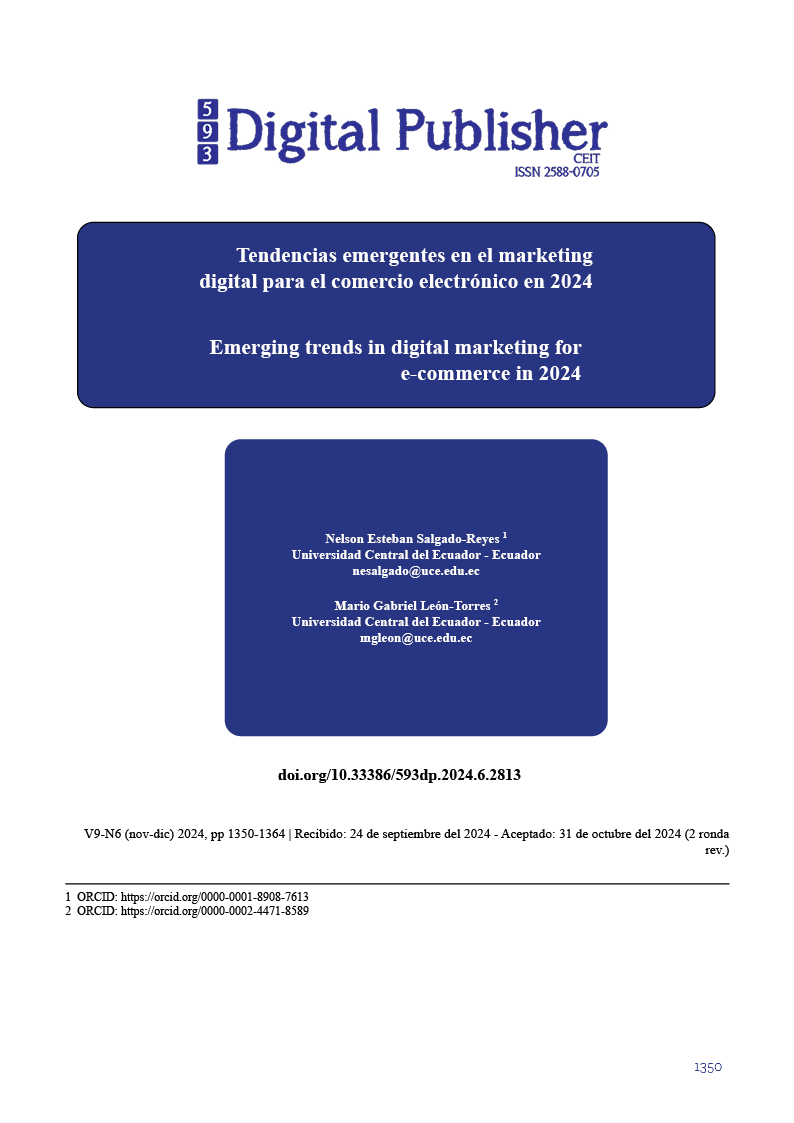Tendencias emergentes en el marketing digital para el comercio electrónico en 2024
Contenido principal del artículo
Resumen
This article examines emerging trends in digital marketing and their impact on e-commerce by 2024. Through a mixed approach combining quantitative and qualitative analysis, technologies such as augmented reality (AR), virtual reality (VR), blockchain, artificial intelligence (AI), voice search, and advanced personalization were investigated. The quantitative analysis was based on data from 50 e-commerce companies, while the qualitative analysis was conducted through in-depth interviews with marketing and technology directors from 10 selected companies.
The results indicate that the implementation of AR and VR significantly improves customer experience and conversion rates, although it faces technical and usability challenges. Blockchain technology increases the transparency and security of transactions, reducing fraud, but presents barriers in terms of technical complexity and costs. AI enables advanced personalization, improving content relevance and sales, although it raises concerns about data privacy. Voice search optimization improves customer service efficiency, facilitating faster and more natural interactions, although integration with existing systems can be complex. Finally, advanced personalization is crucial for customer loyalty, providing personalized and satisfying shopping experiences, although it requires a robust technological infrastructure.
Descargas
Detalles del artículo

Esta obra está bajo una licencia internacional Creative Commons Atribución-NoComercial-CompartirIgual 4.0.
1. Derechos de autor
Las obras que se publican en 593 Digital Publisher CEIT están sujetas a los siguientes términos:
1.1. 593 Digital Publisher CEIT, conserva los derechos patrimoniales (copyright) de las obras publicadas, favorece y permite la reutilización de las mismas bajo la licencia Licencia Creative Commons 4.0 de Reconocimiento-NoComercial-CompartirIgual 4.0, por lo cual se pueden copiar, usar, difundir, transmitir y exponer públicamente, siempre que:
1.1.a. Se cite la autoría y fuente original de su publicación (revista, editorial, URL).
1.1.b. No se usen para fines comerciales u onerosos.
1.1.c. Se mencione la existencia y especificaciones de esta licencia de uso.
Citas
Anantharaman, R., Badhusha M H N, M., Thomas, S., y Soundarraj, P. L. (2024). Analyzing The Role of Digital Marketing in Growth of E-Commerce in India: A Multiple Holistic Approach. Journal of Informatics Education and Research, 4(2), 749-755. https://doi.org/https://doi.org/10.52783/jier.v4i2.835
Casino, F., y Dasaklis, T. K. (2019). A systematic literature review of blockchain-based applications: Current status, classification and open issues. Telematics and Informatics, 36, 55-81.
Chaffey, D. E.-C. (2019). Digital marketing: Strategy, implementation and practice. Pearson UK.
Davenport, T. H., Guha, A., y Grewal, D. B. (2020). How artificial intelligence will change the future of marketing. Journal of the Academy of Marketing Science, 48(1), 24-42.
Huang, M. H., y Rust, R. T. (2020). Engaged to a robot? The role of AI in service. Journal of Service Research, 24(1), 30-41.
Ma, X., y Ma, X. (2024). New marketing strategy model of E-commerce enterprises in the era of digital economy. Helyon, 10, 1-12. https://doi.org/https://doi.org/10.1016/j.heliyon.2024.e29038
McLean, G., y Wilson, A. (2019). Shopping in the digital world: Examining customer engagement through augmented reality mobile applications. Computers in Human Behavior, 101, 210-224.
Nodirovna, M. S., y Sharif oʻg‘li, A. S. (2024). E-Commerce Trends: Shaping The Future of Retail. Open Herald: Periodical of Methodical Research, 2(3), 46–49. https://academiaone.org/index.php/6/article/view/637
Poushneh, A. (2018). Augmented reality in retail: A trade-off between user’s control of access to personal information and augmentation quality. Journal of Retailing and Consumer Services, 41, 169-176.
Rao, S. G., Neha, P., y Sankar, T. (2020)). Emerging Trends in E-Commerce and their Impact on Businessf. International Journal of Advanced Science and Technology, 29(3), 13617 - 13624.
Sanbella, L., Versie, k. V., y Audiah, S. (2024). Online Marketing Strategy Optimization to Increase Sales and E-Commerce Development: An Integrated Approach in the Digital Age. Startupreneur Business Digital (SABDA), 3(1), 54-66. https://doi.org/https://doi.org/10.33050/sabda.v3i1.492
Semenda, O., Sokolova, Y., Korovina, O., Bratko, O., y Polishchuk, I. (2024). Using Social Media Analysis to Improve E-commerce Marketing Strategies. International Review of Management and Marketing,, 14(4), 61-71. https://doi.org/https://doi.org/10.32479/irmm.16196
Sugiharto, B. H. (2024). The Role of E-commerce for MSMEs as a Digital Marketing Strategy in Facing Industrial Revolution 4.0. Management Studies and Business Journal (PRODUCTIVITY), 1(1), 99-107. https://doi.org/https://doi.org/10.62207/80ndq458
Vyas, S. K., Vyas, L., Singh, S., y Joshi, M. (2023). Future of E-Commerce: A Robust Review. En A. Nagar, D. Singh Jat, D. Mishra, y A. Joshi, Intelligent Sustainable Systems. Lecture Notes in Networks and Systems (pp. 697–710). Springer. https://doi.org/https://doi.org/10.1007/978-981-19-7663-6_66
Wedel, M., y Kannan, P. K. (2016). Marketing analytics for data-rich environments. Journal of Marketing, 80(6), 97-121.
Flavián, C., Ibáñez-Sánchez, S., & Orús, C. (2019). The impact of virtual, augmented and mixed reality technologies on the customer experience. Journal of Business Research, 100, 547-560. https://doi.org/10.1016/j.jbusres.2018.10.050
Hoy, M. B. (2018). Alexa, Siri, Cortana, and more: An introduction to voice assistants. Medical Reference Services Quarterly, 37(1), 81-88. https://doi.org/10.1080/02763869.2018.1404391
Huang, M. H., & Rust, R. T. (2018). Artificial intelligence in service. Journal of Service Research, 21(2), 155-172. https://doi.org/10.1177/1094670517752459
Kim, A. J., & Ko, E. (2012). Do social media marketing activities enhance customer equity? An empirical study of luxury fashion brand. Journal of Business Research, 65(10), 1480-1486. https://doi.org/10.1016/j.jbusres.2011.10.014
Loureiro, S. M. C., Guerreiro, J., & Tussyadiah, I. (2020). Artificial intelligence in business: State of the art and future research agenda. Journal of Business Research, 129, 911-926. https://doi.org/10.1016/j.jbusres.2020.11.048
Montgomery, A. L., & Smith, M. D. (2009). Prospects for personalisation on the internet. Journal of Interactive Marketing, 23(2), 130-137. https://doi.org/10.1016/j.intmar.2009.02.001
Nakamoto, S. (2008). Bitcoin: A peer-to-peer electronic cash system. Retrieved from https://bitcoin.org/bitcoin.pdf
Purington, A., Taft, J. G., Sannon, S., Bazarova, N. N., & Taylor, S. H. (2017). “Alexa is my new BFF”: Social roles, user satisfaction, and personification of the Amazon Echo. In Proceedings of the 2017 CHI Conference Extended Abstracts on Human Factors in Computing Systems (pp. 2853-2859). https://doi.org/10.1145/3027063.3053246
Tam, K. Y., & Ho, S. Y. (2006). Understanding the impact of web personalization on user information processing and decision outcomes. MIS Quarterly, 30(4), 865-890. https://doi.org/10.2307/25148757
Wang, Y., Han, J. H., & Beynon-Davies, P. (2019). Understanding blockchain technology for future supply chains: A systematic literature review and research agenda. Supply Chain Management: An International Journal, 24(1), 62-84. https://doi.org/10.1108/SCM-03-2018-0148



